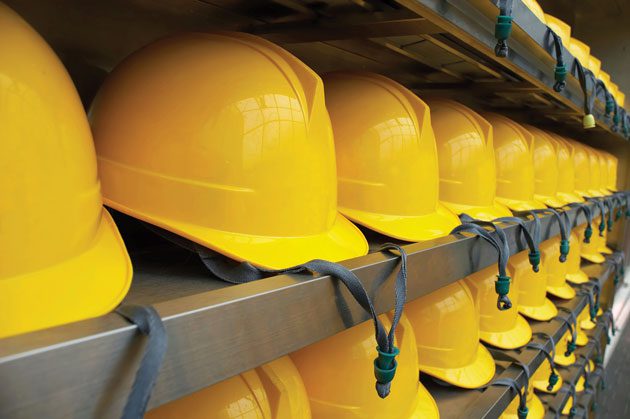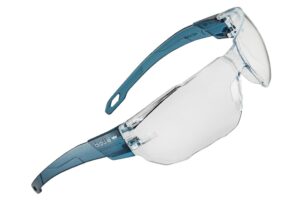PPE is clearly the last line of defence in mine safety but establishing effective systems for PPE use is critical to the success of any PPE programme. James Roughton and Nathan Crutchfield discuss how to develop an effective gloves personal protective equipment (PPE) process. The process begins with human performance concepts, a job hazard analysis for assessing potential risk and hazards, use of the Hierarchy of Controls before selecting PPE, and finally, implementing the use and administration of applicable PPE.
As a case study, we will use the selection of gloves to show how the process should flow. PPE is the last line of defence against hazards and as such, efforts should be made to eliminate hazards well before requiring it to be worn.
Persistent issues with PPE Programmes
Many organisations provide and use certain types of PPE simply because their industry has traditionally used specific PPE. In many cases, no risk assessment has been completed and the use of PPE is based on experience and the organisation’s history of injuries.
Even with a strong history of use, the best safety efforts face ongoing resistance for PPE use. Without vigilance, workers may make the decision to stop using PPE, especially when supervision is not present. There are a number of reasons why workers do not want to use or fail to see the need for PPE:
- Jobs that require PPE may actually have a low probability for injury. The worker may never have experienced a situation where the PPE visibly stopped an injury. The worker begins to believe that PPE isn’t necessary for them and it gets in the way of doing their job. Common complaints are that hearing protection limits hearing, gloves reduce the ability to pick up items, safety glasses fog up, and so on. Unfortunately, this mindset may include supervision and management alike and not just line workers. The safety management team begins to fight against a tide of resistance.
- Even though the PPE is essential if it is not carefully selected it creates an added burden on the worker. PPE may have been selected based on budget, with no consideration of individual needs, comfort, and fit. Poor quality and low-cost PPE may actually create problems with its use.
- A PPE risk and hazard assessment has not been completed specific to each task. A blanket programme is used that requires all workers to use the equipment, even though some areas may not have a hazardous condition. This makes general administration, supervision and disciplinary actions simple; however, this feeds into the resistance to PPE use.
- Workers do not know the ‘why’ of its use and have just been told to wear the PPE or face disciplinary action.
Integrating Human performance into the PPE Process
Traditionally, safety practitioners have used an ‘80%/20%’ split between human error and physical equipment failure. Human performance studies show that a further drill down into this 80/20 split is needed, the 80% being direct human error, such as ‘employee failed to wear proper PPE’.
However, based on studies, this 80% can be further broken down into 70% of human errors are due to ‘organisational weaknesses’ or ‘Latent Errors’, and only 30% are due to individual mistakes.
“The worker begins to believe that PPE isn’t necessary for them and it gets in the way of doing their job.”
If 70% of that 80% is due to organisational weaknesses, then 56% (70% multiplied by 80%) of all loss producing events are due to latent built-in errors from organisational weaknesses. Only 24% (30% multiplied by 80%) is due to individual mistakes such as employee failure to wear or use PPE properly.
More than one half of human error is not from errors made by the employees touching the equipment or performing the tasks. The potential for harmful errors has been unknowingly designed into the job itself!
Adding human performance to the PPE programme
What this tells us is that the PPE process must consider the potential for latent errors previously or already built into the job’s design. So what are latent errors? Latent errors are hidden organisational weaknesses or equipment flaws that lay dormant and go unnoticed, as they have no immediate outcome or negative impact.
Latent errors include various management, supervisory, engineering and administrative actions, directives, or decisions that have the potential for creating the preconditions for error, or that fail to prevent, catch or mitigate the effects of an error.
In the case of PPE, these errors may stem from poor supervision, poor training techniques, poor purchasing criteria, a feeling that PPE is of low importance and so on.
As humans are fallible, we cannot assume that a job was initially perfectly designed for maximum efficiency or effectiveness. In fact, it has or is being completed based on a long term tradition of movements and actions that are actually loss-producing traps for the employees if various job hazards come together at a specific point in time.
The key is to start with Job Hazard Analysis
The job hazard analysis (JHA) approach to doing a hazard assessment for PPE provides a more comprehensive method to assure hazards within each necessary step or task to complete a job are evaluated. The use of the JHA also serves as a written certification that a hazard assessment has been completed.
Firstly, the job hazard analysis provides detail and guidance in regard to the management of the hazards and risks that are embedded in each job, its various steps, and tasks. Secondly, the JHA uncovers and can identify hazardous issues that are built into the job.
Begin by asking and maintaining a questioning mindset of ‘is this a job we need to avoid, modify extensively, or redesign?’ and ‘are there steps and tasks within each job that can be avoided, modified and redesigned?’
Thirdly, the JHA identifies opportunities for improvements in the safety management system. The accumulated knowledge gained about gaps in controls, new hazard and/or risks is essential for continuous improvement.
It can identify gaps and oversights in the selection, use, and administration of PPE. In addition, if workers are involved in the JHA process and PPE selection, the potential for acceptance and use is developed.
The JHA provides the foundation for a risk-based analysis of the workplace. We believe that both hazards and their associated risks should be, to the degree possible, analysed for potential severity and scope of exposure.
As the JHA is completed, consider the following:
- Can any loss-producing precursors be identified that are built into the job design? These may be in the form of non-routine task, extreme task demands, specialised individual ability needs, elements of the work environment such as heat, cold, vapours, dust or noise. Human nature must be considered when selecting PPE, assumptions, habits, bias, working memory, peer pressure, poor risk perception, fatigue, detrimental attitudes among others.
- What needs to be avoided, redesigned, and modified to reduce the hazards and scope of risk based on improved job design? The objective is to eliminate the need for PPE to the degree possible.
- Is this job being completed in tandem with other jobs that have their own hazards and risks that can combine and develop a synergistic effect, creating a greater loss potential and higher risk? A need in many work environments must require PPE in a general area as workers are exposed to the hazards of many jobs and activities
Initial data analysis should be completed before targeting specific jobs for analysis.
This should include:
- A review of the loss history of the work environment – the types of incidents that are occurring and what body parts have been injured.
- What is the frequency of exposure and the severity of injuries?
- From inspections, interviews with workers and observations, what potential for harm has been identified?
- Is there any potential for simultaneous exposure to several hazards?
GLOVES’ SPECIFIC
The JHA provides the information needed for the formal PPE assessment and should address the need for all necessary PPE. The JHA may have identified the following hand related hazards and possible issues that must be individually assessed:
- Motion hazards – gloves may be caught in moving equipment
- Impact – gloves may need to provide cushioning from vibration
- Penetration (sharp objects) – gloves must prevent piercing or cuts
- Crush or pinching objects – gloves may be caught in equipment
- Chemical exposures – gloves must be resistive of specific chemical characteristics
- High (or low) temperatures – gloves may need to provide protection from temperature extremes
- Electrical hazards – if exposure to electrical shock is present, gloves would need to be insulated
- Ergonomics – if manual handling must be completed, gloves that improve grip are needed
SUGGESTED FORMAT FOR THE PPE ASSESSMENT OF GLOVE USAGE
The process begins with a review of the job hazard analysis of the tasks that show exposures to potential hand injuries. Steps include the following elements:
- Identify and list the hazard types and their sources specific to hand injury exposures, and identify where hand injuries may occur.
- Involve the workers that do the targeted jobs.
- Identify any variations in jobs, steps, tasks, and any actions that are infrequently completed or are nonroutine, as these may have additional types of hand exposures.
- Review each hazard and begin an assessment of the scope of risk – what is the severity and frequency of exposure to each hazard?
- Use the Hierarchy of Controls. Can any jobs, tasks or steps be avoided or eliminated? Can hazards be reduced through substitution or modification? Can hand exposures be engineered or designed out of the job? Can administrative controls eliminate or reduce the potential for hand hazards before the final resort of using gloves?
- Administrative controls are actions that include observations of glove use, training on hand protection and why it is needed, signs, and procedures to be followed.
- Identify the gloves to be used for hand protection. The selection of gloves can be enhanced with the use of quality, well selected vendors. They can assist in the validation of the types of glove uses in specific tasks, act as a third party reviewer and may provide training in the use and maintenance of the selected PPE.
- Before a full implementation, select various types of gloves and have employees involved in the evaluation of each type. Determine the pros and cons of each glove evaluated and select the appropriate glove for the given task.
Summary | Take a good look at your PPE Program
Employers are responsible for:
- Maintaining an up to date assessment of the workplace that identifies hazards and determines the type and scope of controls to be maintained or implemented.
- Identifying, selecting, and providing appropriate PPE for employees.
- Assuring that training is provided to employees in the use and care of the PPE, as well as the reasons it is to be used.
- Implementing procedures for maintaining and replacing PPE.
- Reviewing, evaluating, and assuring the effectiveness of the PPE programme.
- Assure that the budget provides for quality PPE and a properly funded process.
Employees should:
- Maintain knowledge about PPE through offered training.
- Understand and follow procedures for the care, cleaning and maintenance of assigned PPE, including the policies on replacing worn out, damaged or defective equipment.
- Communicate to supervisors all PPE related issues without hesitation.
Take a hard look at your Personal Protective Equipment and Job Hazard Analysis process to ensure that they are integrated into human performance improvement concepts. Your efforts may then produce additional insights on the scope of risk, hazards, and improved controls.
“…if workers are involved in the JHA process and PPE selection, the potential for acceptance and use is developed.”
PROFILES
JAMES ROUGHTON
James Roughton is a safety professional with a Masters in Safety, Certified Safety Professional. He is very passionate about developing safety and social networking strategies for small businesses. James wants to spread the word about how to develop and maintain effective safety systems for organisations and implement social networking strategies to maximise exposure on the internet. He provides content and webmasters several blogs:
NATHAN CRUTCHFIELD
Nathan Crutchfield is a Certified Safety Professional and has a professional history that encompasses a full range of risk control programme design, development, implementation and evaluation. He has been involved in organisational risk and loss analysis, safety and risk management programme audit and assessment, management and supervisor training, materials/manual development, loss and risk research, and management presentations. He has provided expertise to a broad array of clients that include public entities, associations, and general industry.
REFERENCES
US Department of Energy Human Performance Improvement Handbook, Volume I, 2009 Job Hazard Analysis, a guide for voluntary compliance and beyond, by James Roughton and Nathan Crutchfield, published by Butterworth Heinemann, 2008.
Personal Protective Equipment – OSHA 3151-2R 2003
This article has been reproduced with kind permission from HSMEmagazine: www.hsmemagazine.com.
Read more Mining Safety News
















Add Comment